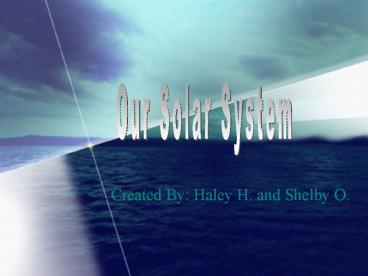Created By: Haley H. and Shelby O. - PowerPoint PPT Presentation
1 / 20
Title:
Created By: Haley H. and Shelby O.
Description:
EARTH: Has the only known life in the Solar System. MARS: Has the Solar System's largest volcano, Olympus Mons, that has a base ... – PowerPoint PPT presentation
Number of Views:294
Avg rating:3.0/5.0
Title: Created By: Haley H. and Shelby O.
1
Our Solar System
- Created By Haley H. and Shelby O.
2
The Sun
- The Suns core is 36,000,000 F.
- The stars are huge balls of superheated gas.
- The sun is in the Milky way galaxy.
- It makes its own light and heat.
3
Mercury
- The planet Mercury has no moons.
- Its surface is rocky with craters.
- The atmosphere is thin, containing oxygen and
helium. - The diameter is 4878 km.
- One day on Mercury is 59 Earth days.
- One year on Mercury is 88 Earth days.
4
Venus
- The planet Venus has no moons.
- Venuss surface is rocky.
- The atmosphere is thick and mostly carbon dioxide
and nitrogen. - Its diameter is 12,100 km.
- One day on Venus is 243 Earth hours.
- One year on Venus is 225 Earth days.
5
Earth
- Earth has one moon. Its surface is mostly water,
with areas of soil covered rock. The atmosphere
is nitrogen and oxygen. Its diameter is 12,756
km. A day on Earth is 24 hours, and a year is 365
days.
6
Mars
- The planet mars has two moons.
- Its surface is rocky and covered with dust.
- The atmosphere on mars is thin and mostly carbon
dioxide. - Its diameter is 6,786 km.
- A day on Mars is 25 Earth hours.
- A year is 687 Earth days.
7
Jupiter
- The planet Jupiter has 16 moons.
- Its surface is a gas planet possibly with liquid
hydrogen surface. - The atmosphere is hydrogen and helium.
- Jupiters diameter is 142,984 kilometers.
- One day on Jupiter is 10 Earth hours.
- A year is 12 Earth years.
8
Saturn
- Saturn has 19 moons.
- Its surface is gas with no solid surface.
- The atmosphere is mostly hydrogen and helium.
- Its diameter is 120,536 km.
- A day on Saturn is 10 Earth hours.
- A year on Saturn is 29.5 or 29 and 1 half Earth
years.
9
Uranus
- Uranus has 17 moons.
- Its surface is gas with no known solid surface.
- The atmosphere is hydrogen and helium.
- The diameter is 51,108 km.
- A day is 18 Earth hours.
- A year on Uranus is 84 Earth years.
10
Neptune
- Neptune has 8 moons.
- The surface of Neptune is gas with no solid
surface. - Neptunes atmosphere is hydrogen, helium, and
methane. - The diameter is 49,538 kilometer.
- One day on Neptune is 19 Earth hours.
- One year is 165 Earth years.
11
Pluto
- Pluto has one moon.
- The surface is water and methane ice.
- Its atmosphere is methane.
- The diameter is 2,350 km.
- One day is 6 Earth days and one year is 248 Earth
years.
12
The Astroid Belt
- The Asteroid belt contains 50,000 known
asteroids. - The largest asteroid is 1,000 km. in diameter.
- Asteroids are made out of rock and metal.
- It is located between Mars and Jupiter.
13
Solar System
- The Solar System contains galaxies, planets, the
sun, the Asteroid belt, the Kuiper belt, and the
Oort cloud. - It also contains the smaller bodies which are
comets, asteroids, meteoroids, and stars.
14
Facts
- MERCURY In sunlit areas the surface is hot
enough to melt lead. - VENUS Venus rotates backwards compared to other
planets. - EARTH Has the only known life in the Solar
System. - MARS Has the Solar Systems largest volcano,
Olympus Mons, that has a base larger than New
Mexico.
15
MORE Facts
- JUPITER The Great Red Spot on Jupiter is a
gigantic storm that has lasted since the time of
Galileo. - SATURN It has a wide, thin system of rings made
of small pieces of rock and ice. - URANUS A possible collision with an earth-sized
object that may have knocked Uranus on its side.
As a result, it rolls around in orbit.
16
EVEN MORE Facts!
- NEPTUNE It is one of the windiest places in the
Solar System. Winds top about 620 miles per hour. - PLUTO It is normally the ninth planet but its
orbit goes inside Neptune and Uranus making it
sometimes the eighth planet. - SUN The Suns surface is cooler than its
atmosphere.
17
- An asteroid is a chunk made of rock and metal
that orbits the sun. - There have been 26 asteroids discovered.
- Asteroids dont have enough gravity to pull
themselves into the shape of a ball.
- A comet is a world of dust and ice.
- Another name for a comet is planetesimal.
- Comets are found in the Kuiper belt and the Oort
cloud.
ASTERIODS
COMETS
18
- Stars are big exploding balls of gas.
- They are mostly made of helium and hydrogen.
- The Sun is the biggest star because it is the
closest.
Stars
19
Milky Way Galaxy
- The Milky Way Galaxy has 200 billion stars.
- A disk, a bulge, and a halo are the three main
components. - Milky ways mass is between 750 billion and one
trillion solar masses.
20
(No Transcript)




















![How to Create An App [9 Steps Guide] PowerPoint PPT Presentation](https://s3.amazonaws.com/images.powershow.com/9442607.th0.jpg?_=20200521129)










